A large dabbling duck closely related to the Mallard and the American Black Duck, the Mottled Duck occupies southernmost portions of the eastern U.S. Mottled Ducks are sometimes seen in 3-bird flights in which a territorial male is chasing away an intruding pair. Mottled ducks are less commonly seen in flocks than most other ducks.
Mottled Ducks are thought to begin breeding at one year of age. Predation and hunting are major sources of mortality, although hurricanes can also have effects on populations. The record known age for a Mottled Duck in the wild is 13 years.
On this page
Description of the Mottled Duck
BREEDING MALE
The Mottled Duck is a large dabbling duck with dark brownish plumage and a bluish speculum on each wing. Males have a yellow to orangish bill. Length: 22 in. Wingspan: 30 in.
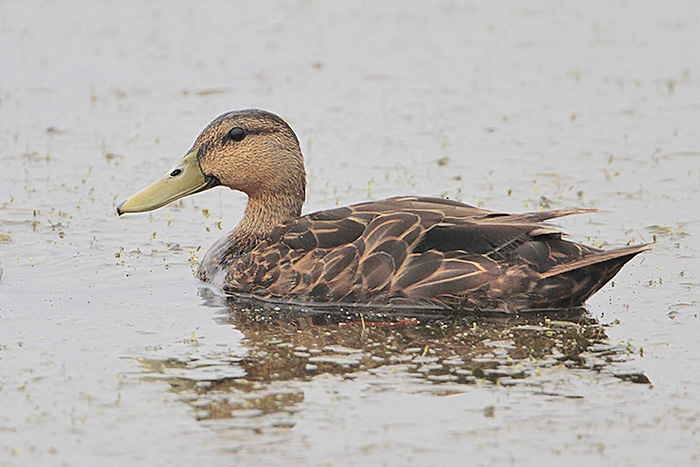
Photograph © Greg Lavaty. This is probably a female. becasue of the greenish bill.
Female
Females similar to make, olive bill.
Seasonal change in appearance
None.
Juvenile
Juveniles resemble females.
Habitat
Marshes.
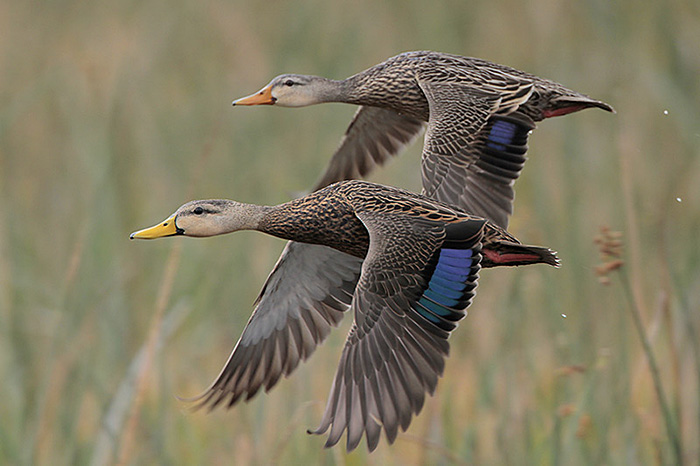
Photograph © Greg Lavaty.
Diet
Seeds, insects, snails, and fish.
Behavior
Forages with bill just under the water’s surface, or by tipping head-first into the water.
Range
Resident in parts of the southeastern U.S. and Mexico.
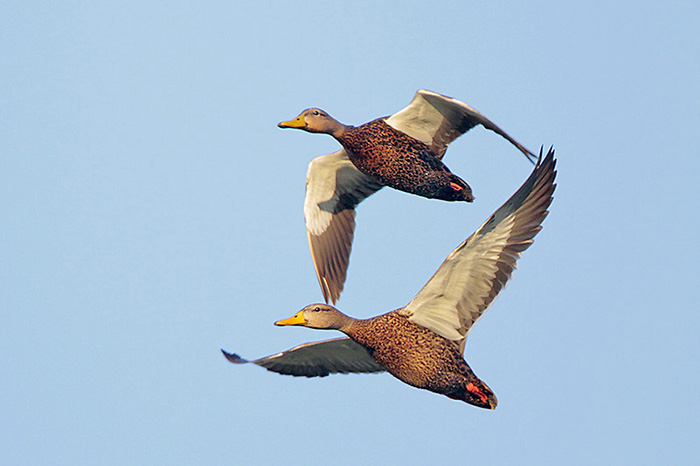
Photograph © Greg Lavaty.
Fun Facts
Droughts can have large, short-term effects on population size.
It is unknown if Mottled Ducks take the same mate in subsequent years.
Vocalizations
Quacks are very similar to those of Mallards.
Similar Species
Female Mallards are very similar. Female Mallard has ornage bill with dark markings. Juvenile Mallards can have oliove bill very similar to female Mottled Duck. Mottled Duck generally darker than Mallard, lacks white in the tail.
Nesting
The nest is a bowl of plant material in a marsh or field.
Eggs: 8-12. ?
Color: White or olive.
Incubation and fledging:
?- Young hatch at 24-28 days.
?- Young fledge (leave the nest) shortly after hatching but remain with the female for some time.
Mottled Duck Pictures
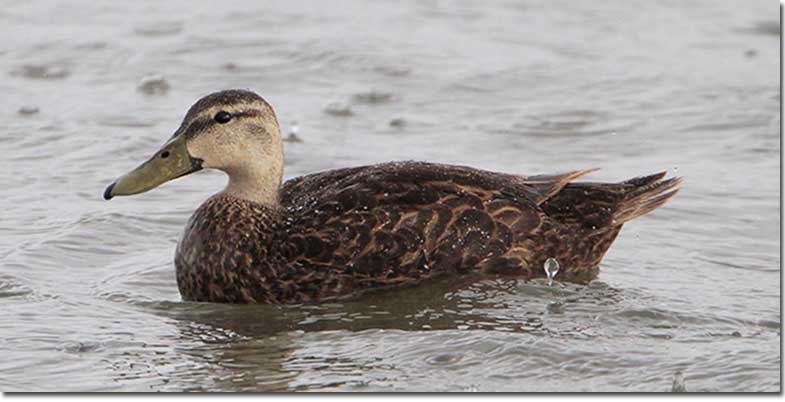
Photograph © Greg Lavaty.
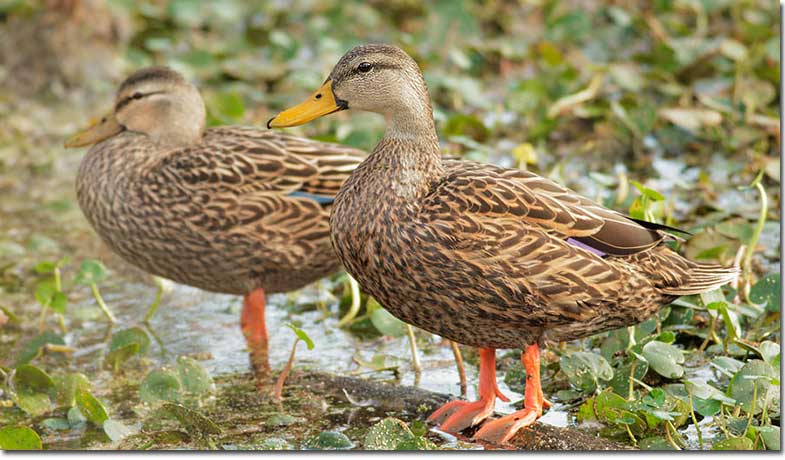
Notice the purple speculum on the male (front bird) and the blue speculum on the female. Photograph © Tom Grey.
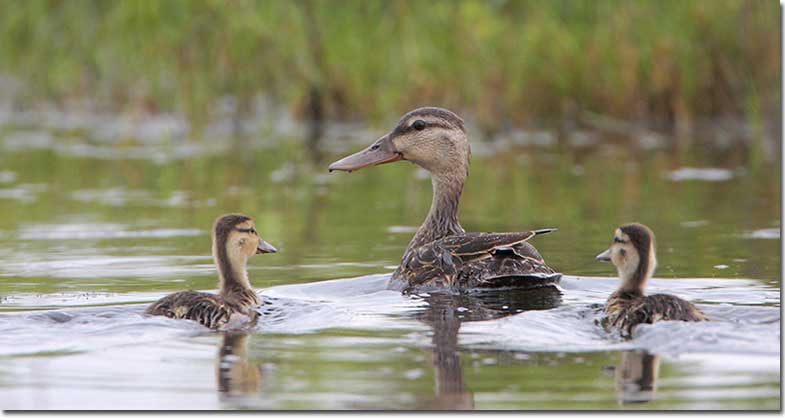
Female Mottled Duck with 2 members of her brood. Photograph © Greg Lavaty.
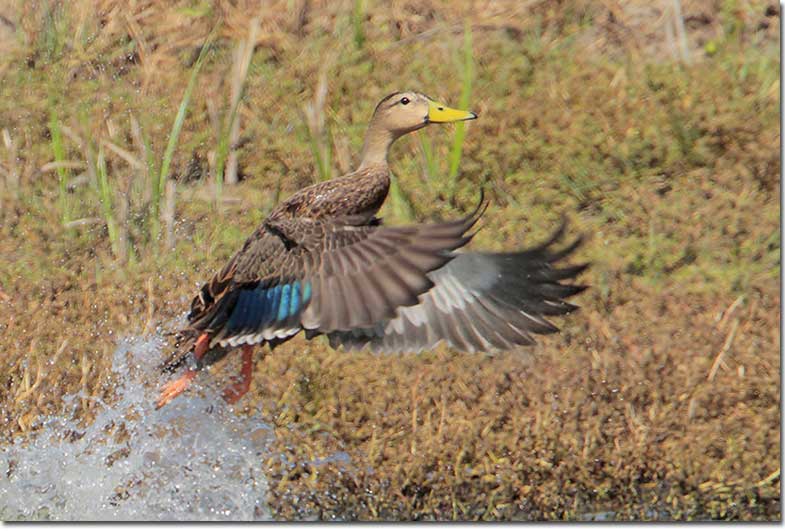
Male on lift off. Note the narrow white band at the end of the speculum. The speculum on the Mallard is generally edged with white on both the leading and trailing edge. Photograph © Greg Lavaty.
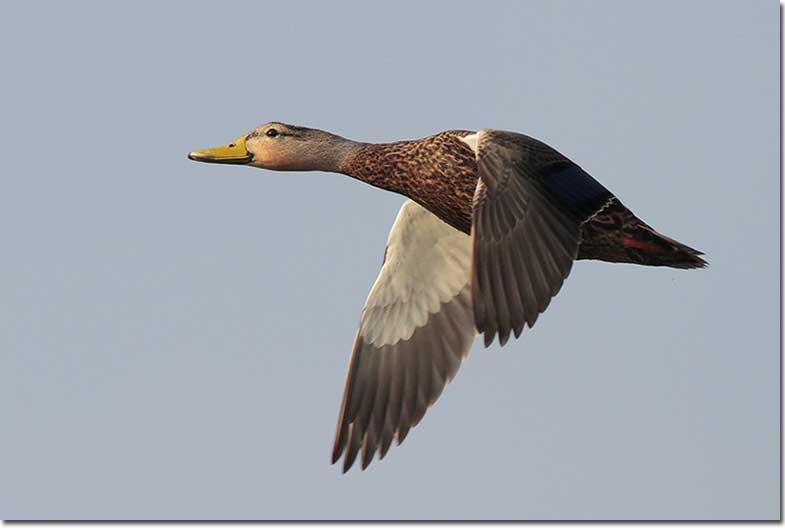
Primaries darker than secondaries on the underside of the wing. Photograph © Greg Lavaty.
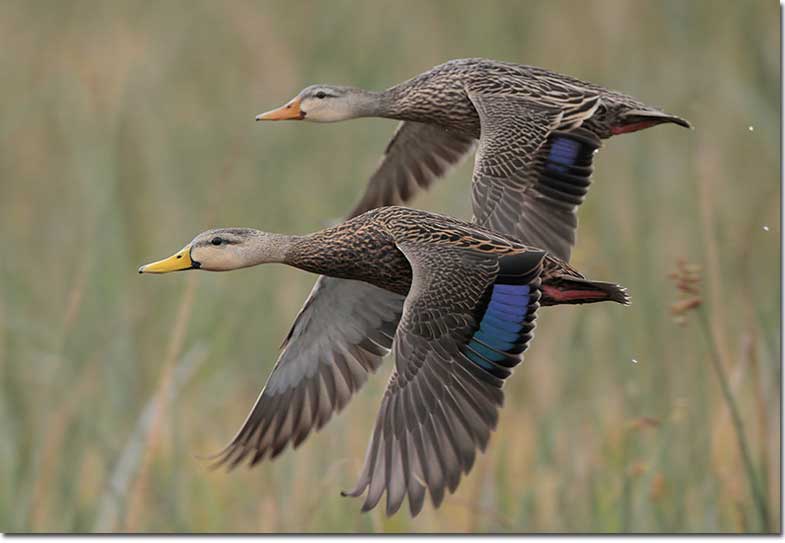
Great photograph showing the pattern and color of the speculum on both male a female. Compare the color of the speculum to the image of the male and female above. Photograph © Greg Lavaty.
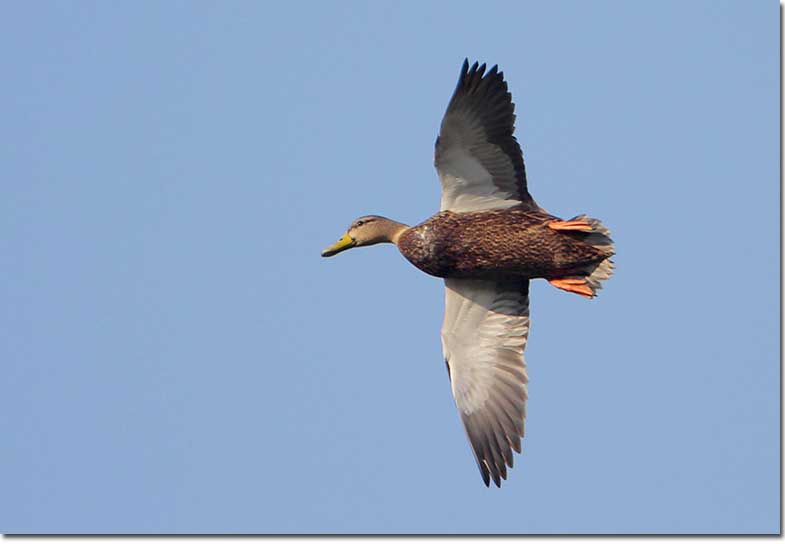
Photograph © Greg Lavaty.
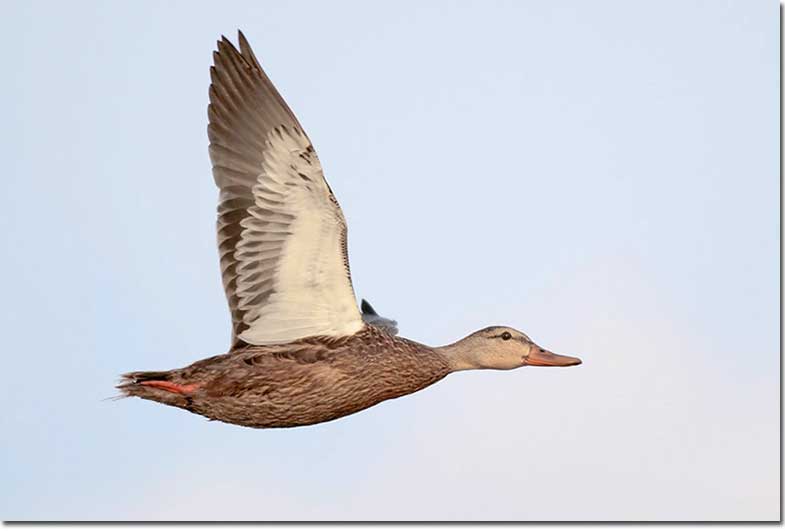
Darker body contrasts with paler head and underwings. Photograph © Greg Lavaty.
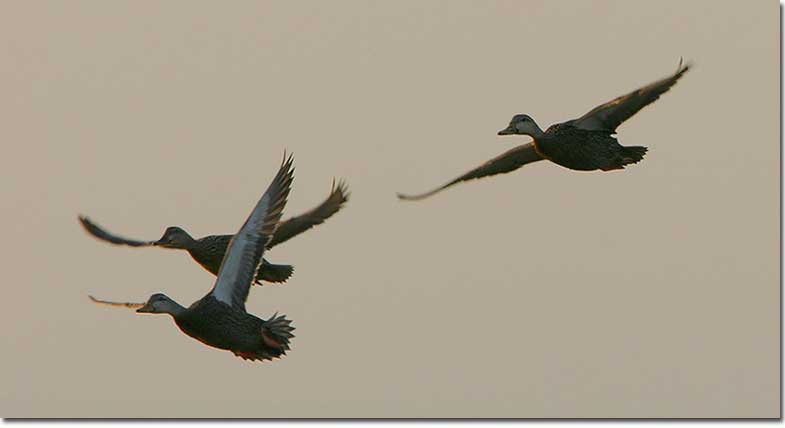
Note the long, pointed wings. Photograph © Greg Lavaty.
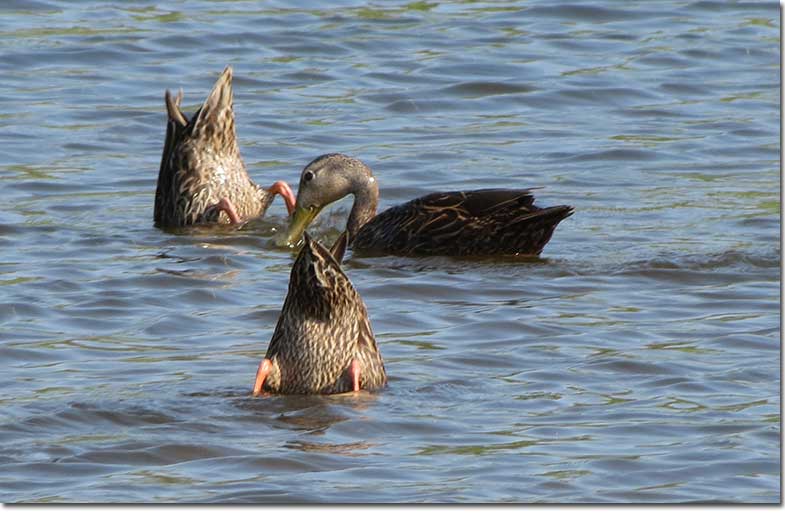
Mottled Ducks will feed in a heads-down, tails-up position. Photograph © Sam Crowe.
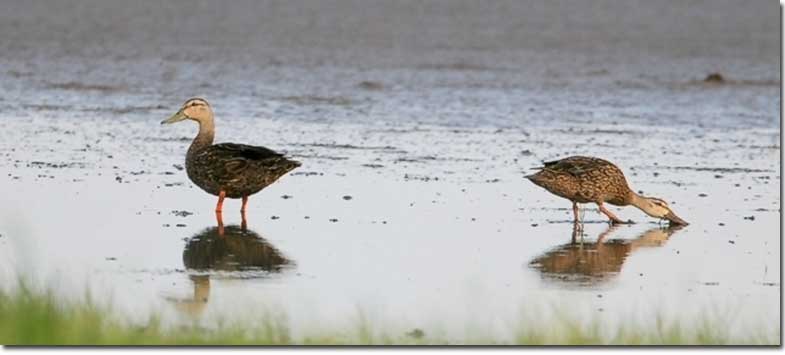
Note the greenish bill and the contrast between the neck and body. Photograph © Greg Lavaty.

This family of Mottled Ducks was headed to the golf course. Photograph © Sam Crowe.
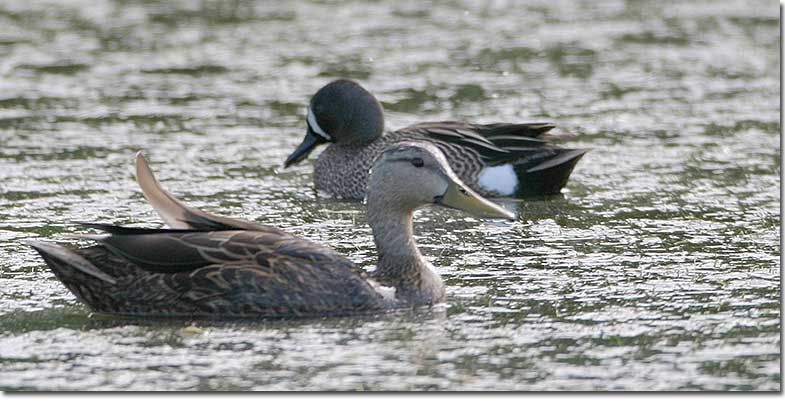
Mottled Duck and male Blue-winged Teal. the Mottled Duck is much larger than the teal. Photograph © Sam Crowe.
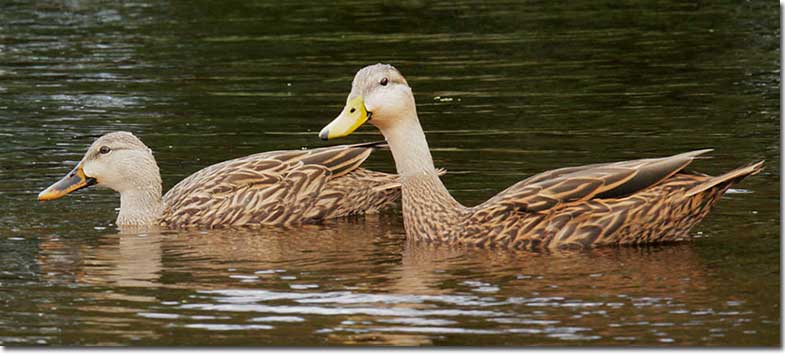
Photograph © Tom Grey.
Bent Life History of the Mottled Duck
Published by the Smithsonian Institution between the 1920s and the 1950s, the Bent life history series of monographs provide an often colorful description of the birds of North America. Arthur Cleveland Bent was the lead author for the series. The Bent series is a great resource and often includes quotes from early American Ornithologists, including Audubon, Townsend, Wilson, Sutton and many others.
Bent Life History for the Mottled Duck – the common name and sub-species reflect the nomenclature in use at the time the description was written.
ANAS FULVIGULA MACULOSA Sennett
Mr. George B. Sennett (1889) first called attention to the characters which separated the ducks of the species Anas fulvigula which inhabit Louisiana and Texas from those found in Florida. He described the Texas bird as a new species and, as the two forms have not, apparently, been shown to intergrade, perhaps he was justified in doing so. In his description he sums up the characters, as follows:
The most marked differences between A. maculosa and A.fulvigula are that the cheeks of the former are streaked with brown, while those of the latter are plain buff; the speculum is purple instead of green; the general effect of the coloration, especially on the under sides, is mottled instead of streaked; the light color everywhere is a pale buff or isabella color instead of a rich, deep buff; and the tail markings also are different, as indicated.
Dr. D. G. Elliot (1898), in commenting on these characters, says:
The streaked cheeks are to be seen among some individuals of the Florida dusky duck, and the color of the speculum is at times merely a question of light, purple and green in metallic hues, being often interchangeable. An ornithologist might readily recognize to which form most of his specimens belonged, but the ordinary observer would probably have difficulty in distinguishing them.
Dr. John C. Phillips (1916), who has made a careful study of these ducks, has this to say on the subject:
In January, 1914, while paying a visit to Mr. E. A. Mcllhenny, at Avery Island, Louisiana, I was able to collect a series of seven of the mottled ducks from the Vermilion Bay region. There are six adult males and one female. Taken on whole, this Louisiana series is even darker than the Texas series; the breasts of the males are very dark, glossy chestnut, and the ground color of the cheeks and chin is distinctly more rufous than in the Texas series or in the Florida series. The cheeks are also quite heavily streaked, and this streaking extends in all cases far below the superciliary stripe; in the Florida ducks the streaking of the cheeks is finer and does not extend so far ventrally on to the chin, while the lores are plain buff and the chin itself is paler in all cases. The pileum of the mottled ducks from Louisiana is more solid black and less streaked black than is the case with the Florida birds; if anything it is darker than the Texas birds. On the upper surface of the Louisiana series and the Texas series the light edges of all the feathers (back, scapulars, rump, and tail) are darker and richer brown, but especially is this so in the Louisiana birds. The speculum character noticed by Sennett does not seem to me to hold good. It was said to be more green and less purple in fulvigula than in maculosa.
To sum up, I should say that the only character which seems important in distinguishing A.f. maculosa and A.f.fulvigula, aside from the generally darker tone of the former, is the coarser and more consistently striped head and neck of A. rnaculosa. In all cases the feathers bordering the sides of the culmen, the lores, are dotted with black in maculosa and plain buff in fulvgula. I believe the richer and more ruddy ground color of the head and neck of A.f. maculosa from Louisiana is partly due to the color of the water and mud in the Vermilion Bay region. These Vermilion Bay ducks are certainly more highly colored than ducks from the Brownsville region of Texas. The form A.fulvigula maculosa, therefore, will probably remain as a valid race.
The characters are slight, but fairly constant, and the new form, whether species or subspecies, seems to be distinct.
Nesting: Audubon (1840) was the first to describe the nesting habits of this duck, although at the time he did not consider it as anything but a common black duck. He writes:
On the 30th of April, 1837, my son discovered a nest on Galveston Island. in Texas. It was formed of grass and feathers, the eggs eight in number, lying on the former, surrounded with the down and some feathers of the bird, to the height of about 3 inches. The internal diameter of the nest was about 6 inches, and its walls were nearly 3 in thickness. The female was sitting, but flew off in silence as he approached. The situation selected was a clump of tall slender grass, on a rather sandy ridge, more than a hundred yards from the nearest water, but surrounded by partially dried salt marshes.
Mr. George F. Simmons (1915) thus describes a nest found in a prairie pond near Houston, Texas:
As is the case with all ponds in this section of prairie, the whole with the exception of a small spot near the center was thickly covered with tall grass, rushes, water plants of various sorts, and sprinkled with a few bushes or reeds, locaIb: known as ‘coffee-bean~~ or ”senna.”
The nest itself was placed about 8 inches up in thick marsh grass and rushes, over water 4 inches deep, and was neatly hidden by the tops of the grasses and rushes being drawn together over the nest. It was but 2 or 3 inches thick, a slightly concave saucer of dead, huffy rushes and marsh grass, supported by the thick grasses and by two small “coffee-bean” reeds. The lining was of smaller sections and fragments of therushesand marsh grass, and a small quantity of cotton; and the 11 eggs were well, though not thickly surrounded by down and soft feathers evidently from the breast of the parent.
Mr. George B. Benners (1887) found three nests near Corpus Christi, Texas; “the nests were built on the edge of the river’s bank and were so carefully concealed that if the birds had not flown up we would never have noticed them.” Mr. James J. Carroll (1900) says that in Refugio County, Texas, it “breeds along the mainland near the beach and on the islands in April.”
Eggs: The eggs of the mottled duck are indistinguishable from those of the Florida duck, except that they seem to average a little smaller. The measurements of 75 eggs in various collections average 54.9 by 40.5 millimeters; the eggs showing the four extremes measure 60 by 40.2, 56.5 by 43, 51 by 41 and 54.5 by 38 millimeters.
Plumages: The downy young of the mottled duck is similar to that of the black duck, but it is somewhat lighter colored and the dark markings on the head are much more restricted and paler. The upper parts are “mummy brown” varying to “Dresden brown,” and to lighter on the forehead and flanks; the sides of the head, in- cluding a broad superciliary stripe, are “Isabella color” or “honey yellow” paling to “cream buff” or “cartridge buff” on the chin and throat; a dusky stripe extends from the bill to the eye and from the eye nearly, or quite, to the occiput; the under parts are “cream buff” or “cartridge buff”; the color of the back is relieved by scapular and rump spots of “cream buff” and the edge of the wing is the same color. The colors become paler with age. The progress toward maturity is apparently the same as in the black duck, the changes are not conspicuous and not easily traced beyond the earlier stages. The juvenal body plumage is worn for only a short time during the first fall; in this the broad edgings of the back and scapulars are “wood brown” or “avellaneous” and those of the lower parts are paler, varying from ” avellaneous” to “vinaceous buff,” the dusky markings on the breast are more longitudinal, less rounded, than in adults. The juvenal wing, characterized by its duller colors and by its in- complete speculum, is worn all through the first year until it is molted at the first complete postnuptial molt; the speculum in the young male is not only much duller in its metallic purple, but the color is much more restricted, occupying less area, and the black borders are narrower and lacking in velvety luster. During the late autumn and winter the progress toward maturity is rapid, until by spring the body plumage is practically adult and only the wings remain to dis- tinguish the young bird. After the first postnuptial molt, when the bird is a little over a year old, the young bird is practically indis- tinguishable from the adult. The broad edgings are much more richly colored than in the young bird, varying from “tawny” on the back to “hazel” on the scapulars and from “hazel” to “amber brown” on the breast; the blackish markings on the under parts are more rounded and blacker; the dark colors of the breast are more sharply separated from the buff of the neck; and the speculum is now complete with its brilliant metallic purple, bordered with broad stripes of velvet black. There is probably no recognizable eclipse plumage, but a complete annual molt in summer.
Behavior: I have never seen this species in life and find practically nothing published on its habits, but there is no reason to suppose that it differs materially in its behavior from the closely related Florida duck. It seems to be practically resident throughout its range. In Louisiana it is called canard noir d’e~t~, summer black duck, as the northern black duck is found there only in winter and is called canard noir d’hiver. Messrs. Beyer, Allison, and Koprnan (1907) say, of the status of Anas fulvigula (now restricted to iruiculosa) in Louisiana:
A regular resident on the coast, and especially on the islands, whence its local name, canard des t.sies. Its numbers are greatly increased during the winter, and at that season it may be found on open lakes, even in the northern part of the State.
DISTRIBUTION
Breeding range: Mainly on the coasts of Louisiana and Texas, less common inland, up the Mississippi valley in Louisiana, and westward nearly to central Texas. South to the mouth of the Rio Grande and perhaps into northern Mexico. Winter range.-~–Approximately the same as the breeding range. Casual records: I-Ias wandered to Colorado (near Loveland, March 15, 1889, and November 6, 1907); Kansas (Neosho Falls, March 11, 1876).
Egg dates: Texas: Twelve records, April 18 to August 20; six records, May 3 to 16. Louisiana: Four records, April 23 to June 1.
FLORIDA DUCK
ANAS FULVIGULA FULVIGULA Ridgway
HABITS
Up to about 1874, when Mr. Ridgway described this species, the dusky ducks of eastern North America, from Texas to Labrador, were all regarded as one species. This well-marked southern species, characterized by its smaller size, lighter color, and particularly by its immaculate buffy throat, inhabits Florida and the other Gulf States. It is not known to intergrade with the northern black duck, and there is a considerable hiatus between the breeding ranges of the two species. The southern species has since been split into two subspecies, the Florida duck, restricted to Florida, and the mottled duck found in Louisiana and Texas; whether these two forms inter- grade in the intervening States, or where they meet, does not seem to have been determined. Should a hiatus be found to occur between their breeding ranges it might be proper to regard them as distinct species, though all three forms are closely related and probably the intergrades have only recently disappeared.
In the central and southern portions of Florida this duck is an abundant resident bird. I have met with it frequently in the vari- ous portions of Florida that I have visited. On the islands in Indian River, where there were muddy ponds surrounded by marshes, we usually found a pair of these ducks, which were probably breeding there but had their nests too well concealed in the luxuriant growth of tall, thick grass for us to find them. We saw them occasionally in the inland lakes of southern Florida, but we found them most abundant in the extensive marshes of the upper St. Johns River; here they found ample feeding grounds and playgrounds among the dense tangles of vegetation, pond lilies, bonnets, water hyacinths, water lettuce, and other aquatic plants; the dense clumps of taller growth and the impenetrable saw-grass sloughs offered them conceal- ment from their enemies; and they found safe sleeping and resting places in the centers of the larger bodies of water.
Nesting: As I have not been fortunate enough to find one of their nests, I shall have to quote from the observations of others. Dr. D. G. Elliott (1898) says:
It breeds in April, and the nest, formed of grass and similar materials and lined with down and feathers, is placed upon the ground in the midst of matted grass, or under a palmetto, or some sheltering bush, near water.
The following account is published by Baird, Brewer, and Ridgway (1884) based on the excellent field notes of Mr. N. B. Moore: This duck hatches in Florida from the first to the last of April, only one set of eggs being laid in a season, unless it fails in raising its first brood. The nest is always placed on the ground, and the number of eggs is usually 9 or 10. In one instance a nest was discovered which was nearly 300 yards from water, and other nests were met with still farther from water. The one first referred to was cautiously concealed in a thick mass of dead grass held upright by green palmettoes, about 2 feet high. Mr. Moore once noticed a pair of ducks fly from a pond, near which he was seated, and pass over the pine barrens. One of them dropped among the grass; the other returned to the water. Suspecting that the birds might have a nest, he visited the locality the next day, when the birds behaved as before. He soon made his way to the spot where the female alighted, and found her in a somewhat open space. On her return to the pond he soon discovered her nest. It was carefully screened from view on all sides, and so canopied by the standing grass that the eggs were not visible from above. There was a rim of soft down, from the mother’s breast, around the eggs, partly covering those in the outer circle. On viewing the nest the next day this down was found to have been drawn over all the eggs. Mr. Moore took them and placed them under a hen; and six days after they were hatched. This was early in April. It would appear, therefore, that the statement that the male forsakcs his mate during incubation is not well founded; for in this instance the male bird, about the twenty-fourth day of incubation, still kept in the vicinity of the nest. It is, however, the universal belief that he does not assist in rearing the young.
Mr. C. J. Maynard (1896) “found them breeding on Indian River, the nests being placed on the drier portions of the marshes, in grass which was about 18 inches high.”
Eggs: The Florida duck lays about 8 or 10 eggs which are similar to those of the black duck, but slightly smaller or shorter and rounder. In shape they are elliptical oval to oval. The shell is smooth and in some specimens slightly glossy. The color is creamy white or greenish white. The measurements of 52 eggs in various collections average 57 by 44.3 millimeters; the eggs showing the four extremes measure 62 by 46, 49.8 by 49, and 55 by 40.5 millimeters.
Young: The period of incubation is probably the same as with the black duck, 26 to 28 days. It is performed wholly by the female, although the male does not entirely desert her. Mr. C. J. Maynard (1896) writes of the behavior of the mother and young:
Tue eggs were deposited during the first and second weeks of April; then about the 1st of May, I would frequently see flocks of little downy ducklings following the female, but unless I took care to conceal myself, I did not enjoy watching these little families long, for as soon as the parent became aware of my presence, she would emit a chuckling note, when away they would scamper, helter-skelter, into the nearest grass, where it was impossible, upon the most careful search, to discover a single young. I once surprised a brood, when they were some distance from any place of shelter, for they had ventured out upon the mud of a creek, at low tide, and I chanced to come out of the high grass, just in front of them. The old duck appeared to com- prehend the situation at once, for she came directly toward me, driving her brood before her, hoping to engage my attention by a display of bravery, while the young escaped into the sheltering vegetation behind me; but placing my gun on the ground, I stooped down and grasped two of the little fellows as they were running past. The diminutive ducklings uttered shrill cries when they were c-aptured, which drove their parent nearly frantic, for regardless of possible consequences, she dashed about in front of me, with ruffled feathers and half-closed wings, often coming within a foot of me, at the same time, quacking loudly. This outcry attracted the attention of the drake, but he did not approach very near, merely circling about, some 50 yards distant, quacking softly. Leaving the old female to care for the remainder of the brood, I carried my captives into camp and placed them in a box, the sides of which were about a foot and a half high, but young as they were, they managed to escape.
Plumages: As I have seen but few downy young of the Florida duck, as the series of immature birds available for study is very scanty and as the two subspecies are so much alike in these respects, I prefer to refer the reader to what I have written about the plum- ages of the mottled duck, which will probably fit this subspecies equally well.
Food: According to Mr. W. L. McAtee (1918) the southern black ducks eat a larger proportion of animal food than their northern relatives. Based on the examination of 48 stomachs by the Biological Survey he found that 40.5 per cent of their food consisted of animal matter. Mollusks compose five-eighths of the animal food and snails as large as 1 inch in (liameter are eaten. Insect food consists of dragon-fly nymphs (rarely adults), water bugs, caddis larvae, and a variety of beetles and flies, including horsefly larvae. Crawfish and small fishes are eaten in small quantities. Of the vegetable food he says:
Grasses are the most important element of the vegetable food of the southern black duck, forming almost half of it. Frequently the rootatocks are dug up and devoured, and some stems and leaves are eaten. Of the grass seeds consumed, cultivated rice is most important. Most of that found in the stomachs was waste, being taken in winter, and as it included red rice, some good was done by eating it. However, as the southern black duck spends the summer in the country where much rice is grown, it has the opportunity of feeding upon the crop in the younger and more appetizing stages. It is said to do this sometimes to a destructive extent. However, the game value of the duck makes it undesirable to take aggressive measures against it on behalf of the rice crop. A toll large enough, if not too large, is taken of the bird, during the hunting season.
Next to grasses the seeds of smartweeds are preferred. They form almost a tenth (9.54 per cent) of the total diet. No fewer than 800 seeds of prickly smartweed (Pot ygonum sagilfaturn) were taken from a single stomach. The seeds and tubers of sedges compose the next largest item, namely, 6.34 per cent. Seeds of water lilies and coon tail make up 3.11 per cent, and seeds, stems, and foliage of pondweeds and widgeon grass, 1.6 per cent. Other items of vegetable food worth mentioning are bayberries and seeds of buttonbush.
Behavior: I can not find much published on the habits of the Florida duck, in all of which it undoubtedly closely resembles the black duck. It is, of course, a surface feeder, but that it can dive, if hard pressed, I have learned to my sorrow in attempting to chase wounded birds; I have seen one dive and swim for several yards under water until it could find concealment among aquatic vegetation, where it remained hidden, probably with its bill protruding, and was never seen again. In flight, appearance, and behavior it is much like the black duck, the white lining of its wings being very conspicuous, but it is not nearly so shy as the northern species, perhaps because it is less hunted.
Game: It is not an important factor as a game bird, because it is not migratory. It inhabits chiefly the less frequented and most inaccessible places in Florida, seldom visited by sportsmen. What few sportsmen visit its haunts usually come in the winter, when this species is widely scattered, or in the spring, when it is mated and breeding, and their time is usually fully occupied with hunting other, more numerous, species which offer better return for their trouble. For these reasons I have never heard of the Florida duck being sys- tematically hunted and I doubt if its numbers are being seriously reduced except where its haunts are becoming thickly settled, culti- vated, or drained. It is the same with them as with many of the western ducks, civilization and agriculture are killing them off faster than gunpowder.
Fall: Mr. Moore says, in the notes referred to above: that in August, September, and the first part of October parties of from 5 to 20 of this species leave the freBh ponds and fly across the bay to sand bars on the inner sides of the Keys, where they spend the night in the pools or coves near the man- groves and return at sunrise tbe next morning. ThoBe at this time were all males; but in January, February, and March mated birds, flying in pairs, spend their nights in tbe same places.
DISTRIBUTION
Breeding range: Florida, mainly in the southern half. Said to be absent from northeastern Florida, but breeds on the eastern coast at least as far north as northern Brevard County and Orange County (Banana River and St. Johns River) and probably farther. Breeds along the northwestern coast of Florida and probably intergrades with maculosa between Florida and Louisiana.
Winter range: Apparently the same as the breeding range, but perhaps some of the West Indies may be included.
Egg dates: Florida: Fifteen records, February 28 to May 22; eight records, April 9 to 25.


